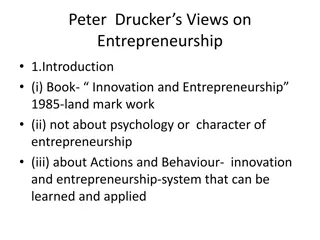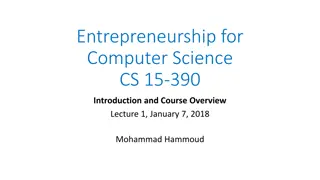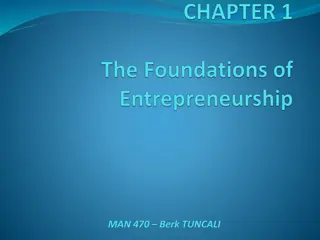Innovation and Social Entrepreneurship Center
Leading center in the region promoting innovation and social entrepreneurship for high social value projects and community welfare. Focus on creativity, entrepreneurship, and tackling social challenges through student involvement and creative solutions.
Download Presentation

Please find below an Image/Link to download the presentation.
The content on the website is provided AS IS for your information and personal use only. It may not be sold, licensed, or shared on other websites without obtaining consent from the author. Download presentation by click this link. If you encounter any issues during the download, it is possible that the publisher has removed the file from their server.
E N D
Presentation Transcript
SILICE SinnoLAB Model- Social Start-up Generator 1.2 Dr. Zeev Greenberg, Dr. Sammy Bahat, Dr. Ofra Wolter, Dr. Ayala Cohen, Dr. Anat Raviv
Indicators for Social Entrepreneurial Activities Activity Range QUASI BUSINESS ACTIVITY IN SOCIAL ORGANIZATION SA SE TRADITIONAL SOCIAL ACTIVITY SOCIAL SOCIAL ENTERPRISE SOCIAL ENTREPRENEURSHIP TRANSFORMATION Creativity + - Innovation Risk & Uncertainty Scalability Viability & Sustainability Engagement
A leading center in the region for promoting innovation and social entrepreneurship which operates according to principles of creativity and innovation. The center will generate social projects of high social value and establish a central platform for solving social issues, social responsibility and promoting the welfare of the individual and the community. The Center will act in the spirit of the College's vision as an institution leading excellence in research and teaching, integrated and involved in the community and promoting economic and social well-being.
The establishment and operation of the Center for the Promotion of Entrepreneurship and Social Innovation within the institutions of higher education, through which it is possible to develop, in new and creative ways, ideas of students and staff in response to social challenges in the community. Expanding students' involvement in social activity in the community.
Models of centers and incubators for business and social entrepreneurship The comprehensive model: The "diamond model" focuses on a center to develop business-technological ventures and social initiatives (a unique model for the Tel Hai team). The classic model: A model operated by the Topaz organization (similar to the operating model of the Center for Entrepreneurship MATI The incubator model for technological entrepreneurship: This model is operated by the Innovation Authority where technological ideas are developed until they reach the stage for raising venture capital. The accelerator model: A model designed to accelerate the growth of the start-up (more suitable for technological start-ups). The hub model: This is a model offering an activity space, professional support and the creation of meetings and brainstorming sessions for groups of entrepreneurs. In practice, it is possible to adapt the principles of each of the models, or a combination of models for implementation in an institution of higher learning
Diamond Model for Promoting Innovation and Entrepreneurship in Universities- Comprehensive Model The external institutional environment Governmental Organization Non Profit Organization Innovation and Entrepreneurship Center Science and technology Social and Humanities Sciences Social Innovation and Entrepreneurship (SinnoLAB) Business and Technological Entrepreneurship Students and Staff Social Enterprises Services (Toolbox): Knowledge, Best Practice, Training, Consulting and Workshops Classes, Laboratories, Workspaces, Equipment Internal Financing Sources Scholarships For Profit Businesses Social Investors and Angels
The Classic Model Personal characteristics of the entrepreneur Receiving Inquiries Fill out an online form Characteristics of the enterprise No GO Preliminary meeting with one of the staff members Value of social contribution Meeting with an interdisciplinary professional committee n No GO The economic model Presentation to the Incubator Board of Directors No GO Recommendations Decision of the Executive Committee No GO Service Package: (Business-social), management services, assistance in obtaining sources of financing, preparation of a business plan, assistance in marketing and access to social investors "
Students Social Innovation Hub-Impact & Outputs http://www.studenthubs.org/impact-14-15/future/
The components of the model and the planning assumptions Infrastructure: The operation of the SinnoLAB is based on the existence of human capital (students, academic staff) and material capital (classes, laboratories, study spaces, equipment, etc.). Organization, management and operations: Steering committee plus two or three professional committees that will deal with identifying, examining and filtering social venture ideas which have potential of social and community value. Managers: Management of the SinnoLAB on a regular basis in order to promote the social ventures in the organizational and financial aspect. Teachers: Internal consultancy of the academic staff within the framework of knowledge, counseling and promotion of the social venture. Financial sources: o Internal funds scholarships, etc. o External sources; Social investment funds, Non-profit organizations.
Mapping Academy-Sponsored Social Enterprises
SinnoLAB- Organizational Structure THE ACADEMIC INSTITUTION MANAGEMENT STEERING COMMITTEE LOCATING AND CHOOSING IDEAS TEAM MANAGER EXTERNAL CONSULTING INTERNAL CONSULTING (TEACHERS) ENTERPRISES, PROJECTS
Tel Hai Case Study Estimation of the potential of ideas and projects in the SinnoLAB (every year) FACULTY OF SOCIAL SCIENCES SOCIAL WORK 480 EDUCATION 780 HUMAN SERVICES 200 TOTAL - 1460 (100%) IDEAS - 150 (10%) ENTERPRISES, PROJECTS 15 (10%) SUCCESS RATE ??????? Ideas- 150 (10%)
A leading center in the region for promoting innovation and social entrepreneurship which operates according to principles of creativity and innovation. The center will generate social projects of high social value and establish a central platform for solving social issues, social responsibility and promoting the welfare of the individual and the community. The Center will act in the spirit of the College's vision as an institution leading excellence in research and teaching, integrated and involved in the community and promoting economic and social well-being.
The establishment and operation of the Center for the Promotion of Entrepreneurship and Social Innovation within the institutions of higher education, through which it is possible to develop, in new and creative ways, ideas of students and staff in response to social challenges in the community. Expanding students' involvement in social activity in the community.
Models of centers and incubators for business and social entrepreneurship The comprehensive model: The "diamond model" focuses on a center to develop business-technological ventures and social initiatives (a unique model for the Tel Hai team). The classic mode: A model operated by the Topaz organization (similar to the operating model of the Center for Entrepreneurship MATI The incubator model for technological entrepreneurship: This model is operated by the Innovation Authority where technological ideas are developed until they reach the stage for raising venture capital. The accelerator model: A model designed to accelerate the growth of the start-up (more suitable for technological start-ups). The hub model: This is a model offering an activity space, professional support and the creation of meetings and brainstorming sessions for groups of entrepreneurs. In practice, it is possible to adapt the principles of each of the models, or a combination of models for implementation in an institution of higher learning























